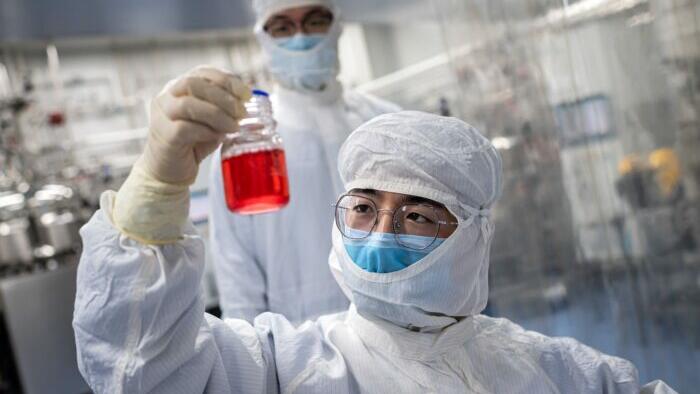


A Chinese patent for a COVID-19 vaccine filed just weeks after the virus emerged in the United States is drawing fresh scrutiny from U.S. investigators examining the origins of the pandemic and potential efforts to conceal early information about the virus.
The February 24, 2020, patent application - submitted by three Chinese entities affiliated with the People’s Liberation Army - outlines a process for developing a "COVID-19 protein vaccine." The document, which predates the World Health Organization’s declaration of a global pandemic, lists 11 inventors. Among them are two scientists affiliated with a neuroscience institute within the Chinese military - a detail that has puzzled U.S. officials, given that neurological symptoms of COVID-19 were not widely known or studied at the time.
The participation of researchers from the Institute of Military Cognition and Brain Sciences - a division of the Academy of Military Sciences in Beijing - has raised particular concern among federal investigators. The institute, which has drawn attention from U.S. defense analysts in recent years, plays a role in the Chinese military’s emerging focus on cognitive warfare - the strategic use of neuroscience in national defense, Just the News reports.
"Significantly, their published research provided limited, or no data of neuropathology observed in the experimental animals, or the neuroprotection afforded by the vaccine," wrote Dr. Robert Kadlec, a former senior Health and Human Services official, in a 2023 report examining the origins of the pandemic. "Institute of Military Cognition researchers’ involvement in such studies suggest an interest in the vaccine’s protection against SARS-CoV-2 early in the outbreak before evidence of its neurological effects were widely known."
Dr. Kadlec, who served in the Trump administration and played a central role in Operation Warp Speed, was among the first U.S. officials to question why neuroscientists were included in early Chinese vaccine development. His report, titled A Critical Review of COVID-19 Origins: Hidden in Plain Sight, was published last September.
Other figures on Capitol Hill have voiced similar concerns. Representative Darin LaHood, Republican of Illinois and a member of the House Intelligence Committee, recently stated that the cover-up of COVID-19’s early emergence in China should be understood in the context of Beijing’s broader strategic ambitions.
"China has a plan to replace the United States, and they're working at it every single day," Mr. LaHood said in a podcast interview this week. "They want to beat us technologically, militarily, economically and diplomatically. And the sooner we wake up to that, the better."
"… And we've seen evidence of this through Huawei and what China… has done with Huawei, what they've done with TikTok, what they've done now with Deep Seek, what they did… in terms of lying and being deceitful with the Wuhan virus," he continued.
Possibly part of that effort: Chinese military strategists are actively developing new methods for using neurology to gain advantages on the battlefield, according to Elsa Kania, Adjunct Senior Fellow at the Center for New American Security.
“On the battlefield, attempts to undermine an adversary could include interfering with the adversary’s capacity for cognition, whether through manipulation or out-right destruction, from disrupting the flow of data to exploiting ideology or emotion,” she wrote in January 2020 for U.S. National Defense University magazine, Prism, which focuses on “emerging disruptive technologies.” -Just the News
At the center of the February 2020 vaccine patent is Zhou Yusen, a senior military scientist at the State Key Laboratory of Pathogen and Biosecurity. Zhou, who previously collaborated with the Wuhan Institute of Virology on SARS and MERS vaccines, is among the 11 listed inventors. According to Senate researchers, Zhou died under unclear circumstances in the months following the outbreak.
The presence of neuroscientists on the patent application - including Yan Li and Gencheng Han - has intensified questions about what Chinese scientists may have known about COVID-19’s broader physiological effects in the earliest days of the outbreak. A separate scientific paper identifies both researchers as members of the Institute of Military Cognition and Brain Sciences. At the time the patent was filed, neurological symptoms of COVID-19 were not widely reported or understood by Western scientists.
Subsequent studies have shown that COVID-19 can have long-lasting neurological effects. A 2022 study published in Nature found that survivors of COVID-19 faced elevated risks of conditions including strokes, memory disorders, migraines, and seizures in the months following infection. Researchers at Duke University reported neurocognitive impairments and sleep disturbances lasting up to three months in some patients.
The earliest Chinese study documenting COVID-19’s neurological symptoms was published in April 2020. According to the study, which was based on clinical data from Wuhan, patient monitoring was still underway five days before the vaccine patent was filed.
The new questions about the early vaccine patent follow revelations this week that a Defense Intelligence Agency unit concluded in mid-2020 that COVID-19 was likely genetically engineered and leaked from a laboratory. That internal study, which described the virus’s spike protein as a "chimera," was not included in official U.S. intelligence assessments. It was only released following Freedom of Information Act requests and is now part of the ongoing congressional investigation.
The Defense Intelligence Agency analysis traced elements of the COVID-19 virus back to a decade-old scientific manuscript published by the Wuhan Institute of Virology, which has worked closely with the Chinese military on coronavirus research, according to the U.S. intelligence community.
Taken together, these findings are intensifying scrutiny of early Chinese responses to the virus, as well as raising new questions about what information may have been known - and withheld - in the earliest stages of the global pandemic.

